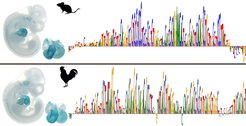The hidden legacy of gene regulation
New bioinformatic method identifies evolutionarily conserved regions in the genome
Researchers from the Max Planck Institute for Molecular Genetics and the Berlin Institute of Health at Charité (BIH), in collaboration with international colleagues, have developed a bioinformatic method to identify evolutionarily conserved regions of the genome that have changed so extensively over time that their DNA sequences no longer match. Dr. Daniel Ibrahim is lead and senior (last) author of the publication in Nature Genetics.

The development of organs such as the heart involves highly conserved genetic programs that are remarkably similar in humans and animals. For example, the amino acid sequences of the genes involved have changed very little over hundreds of millions of years. What has changed significantly, however, are the regulatory regions of the genome that determine whether – and how – these genes become active. The sequences of these so-called cis-regulatory elements (CREs), also known as enhancers, are often not conserved, especially between evolutionarily distant species. Nonetheless, it is assumed that despite sequence divergence, these CREs may still occupy the same genomic positions – that is, they are functionally conserved. However, the extent of this conservation remains unclear.
This is precisely what the scientists set out to investigate. To do so, they needed to determine which enhancers originated from the same ancestral sequence. They analyzed regulatory genome segments in the hearts of chickens and mice at different stages of embryonic development.
In collaboration with the research group led by Professor Martin Vingron (MPIMG) and Boris Lenhard (Imperial College London), they developed a new bioinformatic method that predicts the equivalent position of a regulatory element in another genome, based on exactly where it is located on a specific chromosome.
The newly developed algorithm identified up to five times more conserved regulatory enhancers than conventional alignment techniques. Using chromatin modification data, machine-learing-based sequence analysis, and transgenic mouse models, the researchers were able to show that enhancer function was preserved despite sequence differences. These conserved regulatory elements did not share similar sequences but retained the same activity.
“A key result of our work is a bioinformatic tool called IPP (Interspecies Point Projection), which we are making available to the scientific community. Anyone interested in locating, for example, human enhancers in the genome of mice, rats, chickens, or fish can use it immediately.”
This new method can be used to better understand the genetic basis of human diseases. For instance, many congenital heart defects have unclear genetic causes, which may stem from changes in crucial enhancers. The IPP tool enables researchers to transfer findings from animal models to humans, or to more effectively investigate the genetic causes of diseases in animal models.
Link to publication: Conservation of regulatory elements with highly diverged sequences across large evolutionary distances
Link to IPP-Tool: https://github.com/tobiaszehnder/IPP
News & Views: https://www.nature.com/articles/s41588-025-02194-2
Link to BIH: https://www.bihealth.org/en/notices/when-dna-changes-but-genetic-regulation-remains












